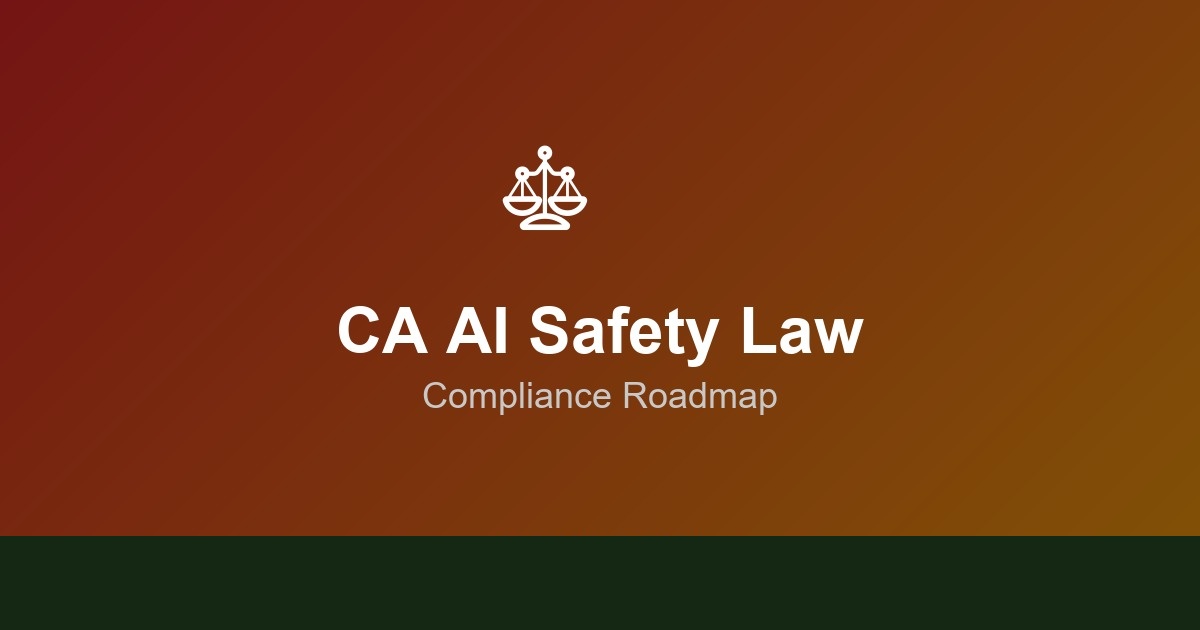California's Landmark AI Safety Law: Navigating Compliance and Unlocking ROI for the Enterprise

California has once again taken a pioneering step in the technology landscape, this time with the enactment of its first-ever AI safety transparency law, the Transparency in Frontier Artificial Intelligence Act (TFAIA, SB 53). Signed into law by Governor Gavin Newsom on September 29, 2025, this legislation is not merely a regulatory hurdle; it represents a pivotal moment for enterprise businesses to redefine their approach to AI development and deployment. For decision-makers at neuronet.dev's target audience, this law signals a new era where proactive compliance and ethical AI practices are directly linked to strategic advantage and measurable return on investment (ROI).
California has once again taken a pioneering step in the technology landscape, this time with the enactment of its first-ever AI safety transparency law, the Transparency in Frontier Artificial Intelligence Act (TFAIA, SB 53). Signed into law by Governor Gavin Newsom on September 29, 2025, this legislation is not merely a regulatory hurdle; it represents a pivotal moment for enterprise businesses to redefine their approach to AI development and deployment. For decision-makers at neuronet.dev's target audience, this law signals a new era where proactive compliance and ethical AI practices are directly linked to strategic advantage and measurable return on investment (ROI).
The New Regulatory Imperative: Why Enterprise Leaders Must Act Now
California's status as a global innovation hub means that its legislative actions often set a precedent for national and international standards. The TFAIA is no exception. Effective January 1, 2026, this law imposes significant compliance obligations and penalties of up to $1 million per violation, primarily targeting “frontier models” and “large frontier developers.” A “frontier model” is defined as a foundation model trained using or intending to use computing power greater than 10^26 integer or floating-point operations. “Large frontier developers” are those with annual gross revenues exceeding $500 million in the preceding year, alongside their affiliates [1]. This narrow scope ensures that the law targets the most powerful AI systems capable of significant and catastrophic impact, compelling the industry's leaders to prioritize safety and accountability.
For enterprise businesses, this isn't just about avoiding penalties; it's about leveraging compliance as a strategic differentiator. Companies that proactively integrate these regulations into their AI strategy will not only mitigate legal and reputational risks but also build stronger trust with customers, attract top-tier talent, and potentially unlock new market opportunities.

Key Provisions and Their Tangible Business Implications
The TFAIA introduces several critical requirements that demand immediate attention from enterprise leaders:
1. Transparency Reports
Before deploying a frontier model, developers must publish a transparency report detailing model specifics (release date, intended uses, modalities) and communication mechanisms. Large frontier developers face additional requirements, including summaries of catastrophic risk assessments and regular reports to the Office of Emergency Services [1].
Business Implication & ROI: This provision fosters greater accountability and can significantly enhance brand reputation. By openly communicating about AI models, businesses can build trust with stakeholders, demonstrate a commitment to ethical AI, and differentiate themselves in a competitive market. Transparency can lead to increased customer adoption and reduced regulatory scrutiny, directly impacting long-term profitability.2. Critical Safety Incident Reporting
Frontier developers are mandated to report "critical safety incidents" to the Office of Emergency Services within 15 days of discovery, or within 24 hours if there's an imminent risk of death or serious physical injury [1].
Business Implication & ROI: Robust internal monitoring and incident response plans are no longer optional; they are a legal necessity. Companies with well-defined protocols for identifying and addressing critical safety incidents can minimize financial penalties, protect human capital, and safeguard valuable assets. The ability to swiftly and effectively respond to incidents protects not only the bottom line but also the company's reputation and operational continuity.3. Frontier AI Frameworks
Large frontier developers are required to publish an annual framework outlining their technical and organizational protocols for managing and assessing catastrophic risks. This includes documentation of alignment with national/international standards, governance structures, risk assessment thresholds, mitigation processes, and cybersecurity practices [1].
Business Implication & ROI: This requirement pushes enterprises towards a more mature and resilient AI governance posture. By investing in comprehensive frameworks, businesses can achieve greater operational resilience, instill confidence in investors, and solidify their position as market leaders in responsible AI development. This proactive approach can prevent costly system failures, data breaches, and regulatory fines, directly contributing to a healthier ROI.4. Whistleblower Protections
The TFAIA enhances protections for employees who report catastrophic risks or violations, prohibiting retaliation and requiring developers to provide annual notice of whistleblower rights. Large frontier developers must also implement anonymous internal reporting channels [1].
Business Implication & ROI: Fostering a culture of safety and ethical AI development is paramount. Empowering employees to voice concerns without fear of reprisal can lead to the early identification and mitigation of risks, preventing potential catastrophic failures and costly litigation. This not only protects the company from legal and financial repercussions but also enhances employee morale and talent retention, contributing to long-term business success.The Stakes Are High: Success or Failure in the New AI Era
The California AI safety transparency law presents a clear dichotomy for enterprise businesses:
Business Success: Companies that embrace these regulations as an opportunity for strategic growth will gain a significant competitive advantage. By integrating transparency, safety, and accountability into their AI development lifecycle, they will attract top talent, build stronger customer trust, and enhance their market reputation. Compliance becomes a differentiator, leading to increased market share, innovation, and sustainable growth. This proactive stance transforms regulatory burden into a catalyst for superior ROI. Business Failure: The cost of non-compliance is steep. Beyond the direct financial penalties of up to $1 million per violation, businesses face severe reputational damage, loss of customer and investor trust, and protracted legal battles. Ignoring these laws is not merely a legal oversight; it is a direct threat to a company's long-term viability and ROI. In an increasingly scrutinized AI landscape, a single catastrophic incident or transparency failure can erase years of brand building and market position.
Actionable Insights for Enterprise Leaders
To navigate this new regulatory landscape effectively, enterprise leaders should consider the following immediate actions:
- Assess Your AI Portfolio: Conduct a thorough audit to identify which of your AI models fall under the scope of TFAIA, particularly those classified as "frontier models."
- Develop Robust Governance: Establish clear internal policies, comprehensive risk assessment frameworks, and agile incident response plans tailored to AI safety and transparency.
- Invest in Transparency Infrastructure: Prepare for the detailed reporting and public disclosure requirements by building systems that can efficiently generate and manage transparency reports.
- Foster a Culture of Responsibility: Empower your teams to prioritize ethical AI development and create safe, anonymous channels for reporting concerns without fear of retaliation.
Conclusion: Proactive Compliance as a Strategic Imperative
California's AI safety transparency law is more than just a new set of rules; it is a bellwether for the future of AI regulation globally. For enterprise businesses, proactive compliance is not a burden but a strategic imperative. It is an investment that drives measurable ROI, mitigates critical risks, and ensures sustainable AI innovation. By embracing these principles, businesses can not only meet regulatory demands but also lead the charge in building a safer, more trustworthy, and ultimately more profitable AI-powered future.
References
[1] Cleary AI and Technology Insights. (2025, October 13). *California Enacts Landmark AI Safety Law But With Very Narrow Applicability*. [https://www.clearyiptechinsights.com/2025/10/california-enacts-landmark-ai-safety-law-but-with-very-narrow-applicability/](https://www.clearyiptechinsights.com/2025/10/california-enacts-landmark-ai-safety-law-but-with-very-narrow-applicability/)
Ready to Implement AI in Your Enterprise?
Our team of AI experts can help you navigate the complex landscape of AI infrastructure and implementation. Book a free consultation to discuss your specific needs.
Book Free Consultation